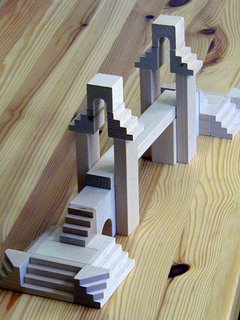 "Falcon" Bildmor Blox have long seemed a bit of an enigma to me. The orange and purple colors are ugly, the blocks look and feel cheap, and exhibit very poor quality conrol, But the selection of shapes, and the packaging, of which there are several versions suggesting an extended manufacturing period, seems to have been done with intelligence, for more critical than usual buyers.
"Falcon" Bildmor Blox have long seemed a bit of an enigma to me. The orange and purple colors are ugly, the blocks look and feel cheap, and exhibit very poor quality conrol, But the selection of shapes, and the packaging, of which there are several versions suggesting an extended manufacturing period, seems to have been done with intelligence, for more critical than usual buyers.
There are much better sets available from other makers, before and after. Much better looking, much better to play with.My best guess is that these sold at a lower price than superior products, and the disadvantages would not have been apparent in a black and white ad. So I suspect that they sold mostly through catalogs and mailorder ads, not through retail stores, but I have seen nothing to back that up. Further research awaits a better internet connection.
Were they depression era? Whatever their circumstance, they have served to demonstrate yet again that a careful selection of shapes, and some good sample designs, can make cheap blocks more educational, and perhaps more satisfying, than a poorly designed set no matter how slick and colorful the latter. So ultimately, the Falcon sets are good Block Play.






